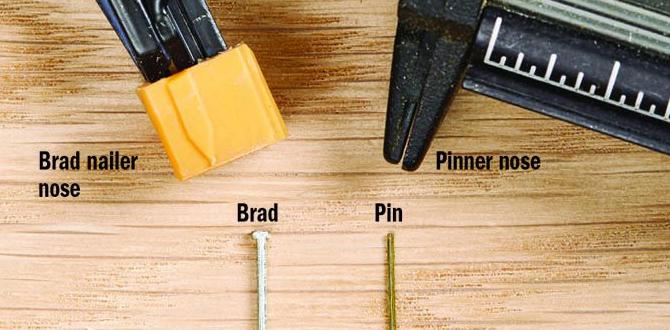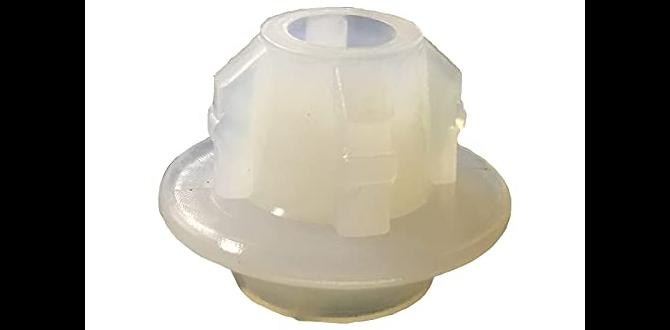Have you ever tried to build something but didn’t know which tool to use? A pin nailer can be a great choice for many projects. It helps you put things together quickly and neatly. But did you know there are different types of pin nailers? Each type has its own special uses. Choosing the right one can make all the difference.
Imagine you’re working on a school project. You need strong connections, but you also want everything to look nice. A pin nailer is like a superhero for woodworkers. It drives tiny nails into the wood without splitting it. This makes it perfect for delicate tasks, like attaching trim or making furniture.
In this article, we’ll explore various uses for a pin nailer. We will compare how different pin nailers work. You’ll learn which one suits your next project best. By the end, you’ll feel like a tool expert! Ready to dive in and discover? Let’s get started!
Table of Contents
Uses For A Pin Nailer Comparison: Discover Their Benefits

Uses for a Pin Nailer Comparison
Pin nailers are handy tools for various projects. They excel at attaching smaller trim or delicate materials without splitting the wood. What’s more, they leave tiny holes, making repairs easy. Want to avoid visible nail heads? Pin nailers are your best friend! They’re great for crafts, furniture assembly, and detailed woodworking. Many people wonder how they stack up against other nailers. Understanding their unique benefits helps in choosing the right tool for your needs. Ready to dive in?Understanding Pin Nailers
Definition and function of a pin nailer. Differences between pin nailers and other types of nailers.A pin nailer is a handy tool for driving small nails, known as pins, into wood. These tiny nails are perfect for delicate projects like cabinetry or trim work because they leave just a tiny hole. Unlike other nailers, pin nailers do not require a head to hold the nail in place, making the finish look smooth and clean. Let’s not forget how they differ from brad nailers and staple guns, which are often bulkier and leave bigger holes. Here’s a quick comparison:
| Type of Nail Gun | Pin Nailer | Brad Nailer | Staple Gun |
|---|---|---|---|
| Nail Size | 23-gauge pins | 18-gauge brads | Various sizes |
| Hole Size | Very small | Medium | Larger |
| Best For | Fine projects | All-purpose | Heavy-duty tasks |
In short, if you want to keep things neat and not leave a mess, a pin nailer is the star of the show!
Common Uses of Pin Nailers
Ideal applications in woodworking and furniture making. Pros and cons of using pin nailers for trim work.Pin nailers are smart tools for woodworking and furniture making. They work wonders for attaching thin trim pieces without splitting wood. You can use them for delicate projects like molding and cabinetry. Pin nailers are quick, making work feel like a breeze! But, if you use them for heavy tasks, you might be in trouble. Here’s a quick table to show their pros and cons:
| Pros | Cons |
|---|---|
| Fast and easy to use | Not for heavy-duty tasks |
| Ideal for trim and small projects | May not hold up under stress |
| Less visible holes | Can jam if not handled well |
In short, pin nailers are your best friends for light projects, but be careful with the heavy stuff!
Benefits of Using a Pin Nailer
Advantages over traditional hand nailing. Impact on finishing and detail work.Using a pin nailer can save you time and energy compared to traditional hand nailing. It shoots tiny nails quickly, making it a breeze for your projects. This means you can finish faster and enjoy more coffee breaks! Plus, a pin nailer is fantastic for detail work. It leaves smaller holes, which means less filling and sanding later. Your finish will look smoother, just like a fresh pair of socks on a hardwood floor!
| Feature | Pin Nailer | Hand Nailing |
|---|---|---|
| Speed | Fast and efficient | Slow and tiring |
| Precision | Very precise | Can be messy |
| Finish | Smoother results | More sanding required |
Comparative Analysis: Pin Nailer vs. Other Nailers
Comparison with brad nailers and finish nailers. Use cases that are better suited for each type of nailer.Different nailers serve different purposes. Pin nailers are great for tiny jobs like attaching small trim pieces. They use very small nails and leave barely a mark. In contrast, brad nailers shoot slightly bigger nails and are perfect for medium tasks, like building furniture. Finish nailers, on the other hand, fire larger nails which handle bigger projects, particularly where strength is key.
| Nailer Type | Best Use Case | Nail Size |
|---|---|---|
| Pin Nailer | Small trim work | 23-gauge |
| Brad Nailer | Furniture assembly | 18-gauge |
| Finish Nailer | Heavy-duty projects | 15-16 gauge |
In a nutshell, choose your nailer wisely! Pin nailers are like ninjas: quiet and stealthy for small tasks. Brad and finish nailers are like superheroes, ready for bigger challenges. Always pick the right tool for the job, and your projects will shine!
Maintenance and Best Practices
Tips for maintaining a pin nailer for longevity. Safety practices when using pin nailers.To keep your pin nailer working well, regular care is key. Always clean it after use. Check for air leaks. Replace worn parts promptly. Use the right nails for your tool. Lubricate all moving parts occasionally. This helps it last longer and work better.
- Always wear safety goggles.
- Keep fingers clear of the nail path.
- Do not point the tool at others.
- Be aware of your surroundings.
Following these methods boosts safety and performance. It makes using a pin nailer easier and safer.
What are safety practices for pin nailers?
Safety practices include wearing goggles, keeping fingers clear, and being aware of your workspace.
User Reviews and Feedback
Summary of customer experiences with various pin nailers. Insights into performance in realworld applications.Customers share many thoughts about different pin nailers. Many users find them easy to use and effective for small projects. Some mention how well they work on delicate materials like trim and molding. Others praise their speed and precision.
- Quick setup saves time.
- Minimal jams improve workflow.
- Lightweight tools are easy to handle.
- Most users enjoy consistency in nail placement.
Real-world use shows that these tools often meet or exceed expectations, making projects simpler and more enjoyable.
What do customers say about pin nailers?
Many customers love pin nailers for their speed and ease of use. They often praise them for making projects go smoothly.
Conclusion
In conclusion, comparing uses for a pin nailer helps you choose the right tool. We found that pin nailers are perfect for small projects and detailed work. They make quick, clean connections in wood without splitting. If you want to learn more, check out tutorials online or visit your local hardware store to see one in action!FAQs
What Are The Primary Differences Between A Pin Nailer And A Brad Nailer In Terms Of Applications And Nail Sizes?A pin nailer uses very tiny nails, called pins, which are less than one inch long. We use it for delicate projects, like attaching thin wood pieces. A brad nailer uses slightly bigger nails called brads, usually up to two inches long. It’s great for holding thicker pieces of wood together.
In What Scenarios Would A Pin Nailer Be Preferred Over A Traditional Hammer And Finishing Nails For Woodworking Projects?You might want to use a pin nailer when you’re working on small or delicate projects. It shoots tiny nails that are less noticeable. This is great for detailed work, like making furniture or toys. Plus, it’s faster than using a hammer, so you can finish your project quickly. A pin nailer also helps you avoid damaging your wood pieces.
How Do The Power Sources (Electric, Pneumatic, Battery-Operated) Of Pin Nailers Affect Their Performance And Usability?The power source of a pin nailer helps it work well. Electric nailers are easy to use and plug into a wall. Pneumatic nailers need air from a compressor, so they are strong but less portable. Battery-operated nailers are handy because you can take them anywhere, but they might run out of power. Each type has its pros and cons based on what you need.
What Types Of Materials And Projects Are Best Suited For Pin Nailers, And Why?Pin nailers are great for small projects like making picture frames or attaching thin wood pieces. They use tiny nails that hold parts together without much damage. You can use them on soft woods, like pine or plywood, and for things like crafts or furniture. They help your work look neat and clean because the nails are so small.
What Safety Precautions Should Be Taken When Using A Pin Nailer To Prevent Accidents And Ensure Optimal Performance?When using a pin nailer, always wear safety goggles to protect your eyes. Keep your fingers away from the tip. Make sure to unplug it when not in use. Always point the nailer away from yourself and others. Check if it’s working properly before you start.



